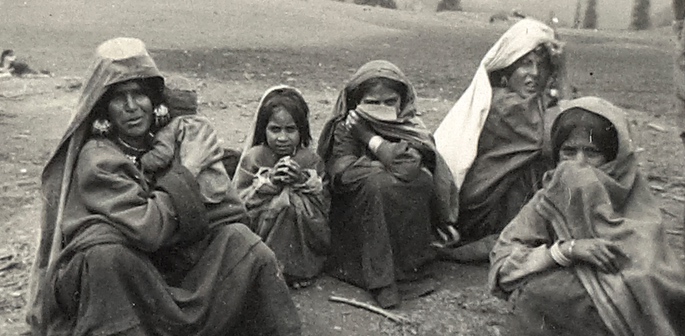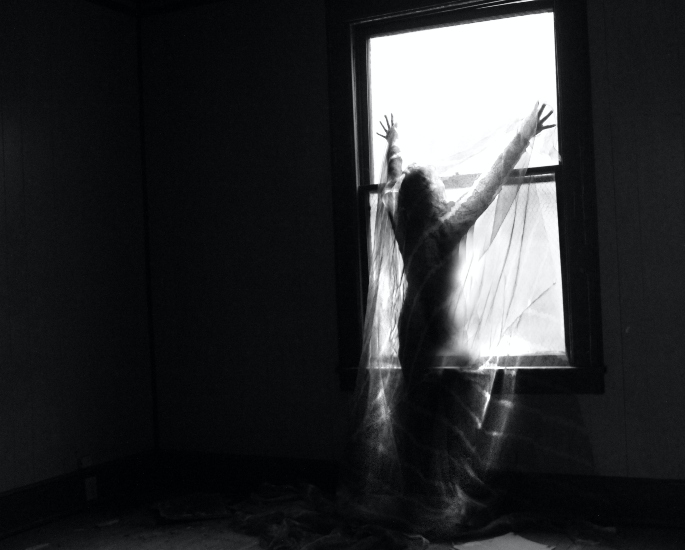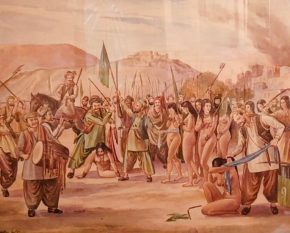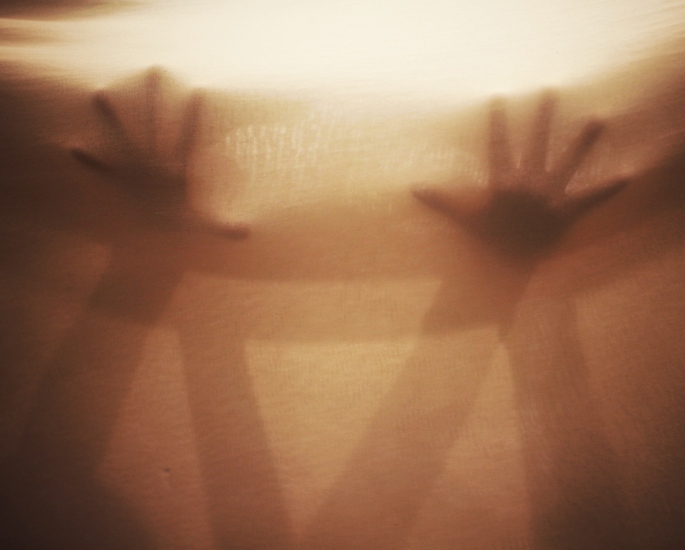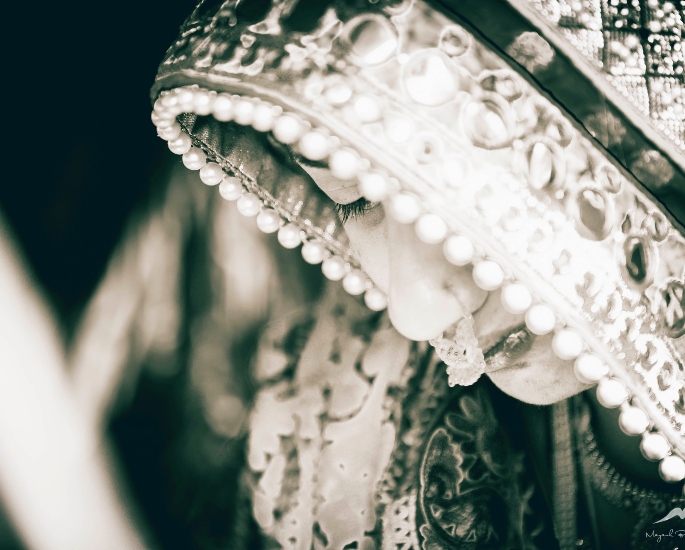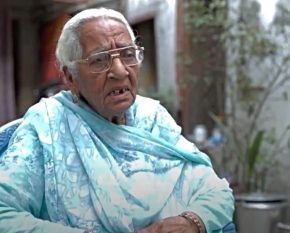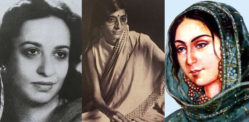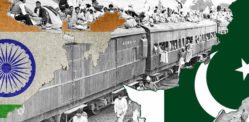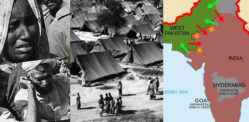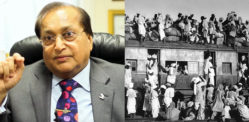"No space remained. A few came up and jumped again."
Women’s experiences during the partition of India reflects a time when their purity represented the honour of an entire community.
In 1947, the division of British India saw the emergence of two independent states, presently known as India and Pakistan. This is following a 200-year rule by Britain.
It was a gruelling time for everyone, with many individuals having no choice but to migrate immediately. It was one of the largest mass migrations in history.
The events that unfolded created an overwhelming refugee crisis, with approximately 12 million people becoming refugees.
Living under such adverse conditions, one can imagine that there were many violations when it came to the rights of women.
However, the study of women’s struggles during the partition only came to consideration during the 1984 anti-Sikh riots This is nearly four years after the partition took place.
The primary reason for this is because feminists were relatively uncommon and the fight for equal rights had yet to begin.
While some women resisted their society’s patriarchal structure, the diversity of women’s identities meant that many conformed to male superiority.
In fact, through her research, Urvashi Butalia, an Indian writer and activist, found that women often assisted men in carrying out violent attacks:
“In one instance of the killing of some 55 Muslims in urban Bhagalpur, a Hindu woman had tried to protect them, but had been stopped by her neighbours (all women) from even giving water to the dying.”
Unfortunately, these stories often do not receive much limelight, particularly with the portrayal of partition as a liberating moment in history.
The excitement of independence overshadowed the tragedies of division.
Women had to experience horrific ordeals. These include rape, mutilation, murder, forceful marriages among other mass atrocities.
DESIblitz investigates how the horrors of India’s partition provoked a gendered partition, leaving women as one of the biggest victims.
Rape and Mutilation
Political conflicts often instigate sexual assaults on women, and India’s partition was no exception. Women became objects of violence, specifically through rape and genital mutilation.
Rape and mutilation were, at the time, a way to completely corrupt female innocence.
The true intention behind these acts was to disgrace the community women belonged to. Rape and mutilation were merely the means to achieving that goal.
In a video covering the history of sexual violence during conflict, Satish Gulraj, an Indian painter, remembers a time when an entire girls school was assaulted:
“A Muslim girls’ school had been raided. All the girls had been brought out, stripped and taken in procession to this location where they were being systemically raped.”
It is estimated that up to 100,000 women were captured or raped.
At times, women were experiencing rape by multiple men as their sons, daughters and husbands watched on helplessly.
Some had slogans such as ‘long live Pakistan/India’ plastered across their bodies as a way to declare their defeat.
They would then be showcased, naked, in front of their village, being engraved with religious symbols of the ‘other’ side.
However, this does not mean their own men were on their best behaviour. In actuality, men were raping their own women as a way of restoring masculinity after facing loss in battles.
Irrespective of whether it was their own or an outsider, men faced no judgement.
Furthermore, mutilation represents an attack on an entire nation. The most common type of mutilation was the amputation of breasts and knifing open the womb.
Professor Navarro-Tejero compares this to a fictional novel where sacks of mutilated breasts were discovered on a train in Lahore.
She notes the cultural significance of mutilation, observing:
“In nationalist terms, the mutilated breasts can be read as a sign of the intention to remove the enemy’s community.”
Navarro-Tejero’s comparison highlights how men were reducing women to their reproductive system as objects of patriarchy.
Equally, it’s important to recognise the acts of mutilation stripped women of the qualities that made them valuable in society.
Breasts symbolise a women’s reproductive system, beauty, motherhood and vitality. Removing them desexualises them.
Thus, the tag of the ‘fallen woman’ came into effect, never to recover her dignity.
Subsequently, the victims family would send women to a purifying camp or kill them, hoping to reclaim the communities honour.
Though the abuse is generations old, many testimonies have only surfaced in contemporary times due to the cultural context of the partition.
The culture of 1947, was one where women could not openly discuss the brutality they were experiencing. And, sadly, much of the exploitation women experienced will remain untold.
Hence, with no other outlet, many women committed suicide in an attempt to escape.
Conversion and Suicides
For many, partition came as a surprise because life before independence was harmonious between the different faiths.
However, the partition was partly due to the tension between Hindus, Muslims, and Sikhs.
Hindus who made up 80% of India’s partition remained in India and Muslims who were the biggest minority group, making up 25% of the population, left for Pakistan.
Nawab Bibi, a survivor of the partition recalls the bloodshed she witnessed at mosques:
“At that time it felt like the Hindus didn’t spare a single Muslim. They came after each and every one of them.
“People would go and hide in the mosques. The Hindus would bang the doors and burn them down and kill them.”
The events that took place in this mosque set the tone for what women, specifically, would experience down the line.
As religious-based violence eventually broke down communities, a culture of forced religious conversion arose.
Urvashi Butalia found that elements of this tension took various forms and had begun even before the partition:
“During an eight-day period from March 6 to 13 much of the Sikh population was killed, houses were decimated, gurudwaras destroyed…
“In one of (the) villages, Thoha Khalsa, some 90 women threw themselves into a well in order to preserve the ‘sanctity’ and ‘purity’ of their religion, as otherwise they would have had to face conversion.”
A lady named Mann Kaur was the first to jump after reciting some prayers. Estimates reveal that over 93 women did the same as Kaur, with some holding children in their arms.
Regrettably, not many are alive to tell their respective stories.
However, a young Muslim boy of the time remembers women forcing themselves to death to protect their honour:
“In about half an hour the well was full of bodies…”
“I went closer and realised that those who were on top were trying to submerge their heads so they don’t survive.
“No space remained. A few came up and jumped again.”
This mass suicide was widely publicised around the world and it symbolised women’s desperation during India’s break-up.
Although men were also experiencing this method of death, it was more probable among women.
This is because men who believed they could fight (and win) would not have to kill themselves. Instead, they would have to kill the enemy to avoid religious conversion.
In Thoha Khalsa, suicides began after Muslims, who invaded the village, broke a truce they made between themselves and Sikhs.
The truce outlined that the Muslims could loot the Sikhs’ houses and receive their desired Rs 10,000. But they could never kill, dishonour, or convert their men, women, and children.
There was a particular worry that the women who were mostly between 10-40 years old were at risk of rape.
After the Muslims broke the pact, Sikh men began preparing to fight to defend their religion. And the women started circling the well, preparing to jump.
This raises the question of how many women had a forceful death, and how many decided to die? The reality is that many women committed suicide as a ‘sacrifice’ for their community.
Reports suggest that men were coercing their women into jumping into the well to benefit themselves. They claimed that death, through sacrifice, made them heroes.
This form of glorification saw the declaration of women as ‘martyrs’, setting the best example for all religious women.
However, those women refusing to kill themselves and ready to fight became victims of their own families who went on to murder them.
The young boy still recalls seeing a man named Bhansa Singh, killing his wife with tears in his eyes.
Such cases are referred to as ‘honour killings’, which are still very prevalent in South Asian communities.
Moreover, it is important to recognise that many survivors suggest faith was not the core motivation for this violence; it was land and territory.
Abduction and Relocation
Official accounts have estimated 50,000 Muslim women in India and 33,000 non-Muslim women in Pakistan experienced abduction.
In The National Archives, Mohammad, a survivor of the partition, recalls the inhumane acts of abduction women experienced:
“There were young women – I can still remember – who were abducted from their houses and taken away by these rascals, raped and some of them were returned, some of them probably killed or something.
“Nobody knew what happened to these girls… we must feel ashamed.”
The severity of the abductions put the government on both sides under intense pressure to resolve the issue.
Three months after India’s partition, an Inter Dominion Conference held at Lahore concluded that both states should recover abductees.
The agreement is ‘the Inter-Dominion Treaty’, meaning that Pakistan and India would return women to their respective countries. The resolution stated:
“During these disorders, large numbers of women have been abducted on either side and there have been forcible conversions on a large scale.
“No civilised people can recognise such conversions and there is nothing more heinous than the abduction of women.
“Every effort must be made to restore women to their original homes with the co-operation of the governments concerned.”
In the space of nine years, there was an approximate recovery of 22,000 Muslim women and 8000 Hindu and Sikh women.
The issue with the treaty, however, is that it was forcing women to move to countries purely based on their religion. It denied women the right to chose where they would live.
Muslim women in India, for example, had to leave Pakistan – an Islamic country – by default.
Also, there were reports of women committing suicide after returning home because their now-impure selves were tarnishing their family’s reputation.
Luckily, the State issued pamphlets, stating women who were sexually active during their abduction were purified after three menstrual cycles. Thus, their family could accept them back.
Still, there were numerous reasons for abducted women to prevent their return. Some were fed lies about the living conditions of their previous homes by their abductors.
They learnt of their houses back home being burnt down or that all women had been killed.
However, Menin and Bhasin found that in most circumstances, abducted women would actually prefer to stay in their new homes:
“Of the 25-30 women… only one could be said to be unhappy and in unfortunate circumstances.:
“All the others, though nostalgic and distressed at not being able to meet their natal family freely, seemed to her to be settled and held in regard both by the community and their new families”
They interviewed a social worker who tried to relocate abducted women during the partition. She explains how the process simply felt wrong:
“They were determined to stay back because they were very happy. We had to use real force to compel them to go back.
“I was very unhappy with this duty – they had already suffered so much, and now we were forcing them to return when they just didn’t want to go.
“I was told, “These girls are simply creating a commotion for nothing, their case has been decided and they have to be sent back.”
Contrastingly, there is little evidence that men had similar experiences of recovery; owing to their gender to make their own choices.
Forced Marriage and Abortion
After the abduction, many women had to forcefully tie the knot with their captors.
According to Women’s Media Centre, Meera Patel references ‘The Great Partition: The Making of India and Pakistan’ by Yasmin Khan to express why men kept women instead of discarding them:
“Rather than being raped and abandoned… tens of thousands of women were kept in the ‘other’ country, as permanent hostages, captives, or forced wives.”
These abducted women were working as domestic slaves, experiencing unwanted marriages with their abductors.
While this may sound horrible at face value, many believed that marriage proposals were a positive thing.
Anis Kidwai, a social worker of the time, argued that ‘abductor’ was an unfair word to describe these men:
“Rescuing her from the horror this good man has brought her to his home. He is giving her respect, he offers to marry her. How can she not become his slave for life?”
They would cook, clean, entertain and fulfil their husband’s sexual desires. As a result, many women fell pregnant.
Countless women were forced to either abandon or abort their children.
However, abductees were more likely to abort their babies once they returned to their home country.
This is because the unborn children were thought to be ‘polluted seeds’. The process became familiar as ‘cleansing’.
Arunima Dey delves deeper into this process in her writings:
“When recovered by the government, in order to be accepted back into their families, the women had to abandon these (what one may call) mixed-blood children…
“Especially for Hindus… it was unimaginable for them to accept a woman with a Muslim man’s child who would be a constant reminder of the woman’s and the religion’s shame and dishonour.
“A Hindu woman who had been forcefully converted into a Muslim could be converted back.
“However, a child who was born half Hindu and half Muslim belonged nowhere.”
The child would also be a constant reminder for the family that the father was a rapist.
The cruelty of the abortions was so extreme that the government had to publish pamphlets. The pamphlets were reassuring communities their women and children were still pure.
Additionally, the state decided to include the restoration of a male child under the age of six to their ‘rightful’ residence.
But of course, this had its own issue, with abortions and abandonment being more popular amongst daughters than sons.
Although the aim was to prevent abortions, many women were undergoing illegal and unsafe abortions instead.
These cases suggest that the partition was not just a battle for land, but also a women’s honour.
Trauma
The consequences of the partition are still visible, both psychologically and politically.
The tragedies that took place undoubtedly left thousands of men and women deeply traumatised.
Correctly treating the psychological strain the partition had on these individuals is very important. However, this did not happen.
In fact, most attempts to restore women’s experiences were led by wrong intentions and, in turn, hurt them more.
It is not easy to forget witnessing the murder, rape, abortion, abduction, forced marriages of other women.
The women that continue living with memories of such barbarity deserve help and relief.
Women need humanitarian aid and support to undo all the historic and contemporary damage.
In a 2017 YouTube series about unheard partition stories, Kasura Begum, a survivor recalls how her experience of partition still keeps her up at night:
“They were very cruel to us…That incident on the 14th of August, I am still not able to sleep at night although I am so old now.
“I cannot forget that incident for a minute.”
In the same series, another woman, Nawab Bibi, who helplessly watched the savageness of partition said:
“Some people got reunited with their families but after several years – such was the time.
“It is hard enough to deal with a single trauma. But when you see so many atrocities around you, it scars you for life.”
This is the price they had to pay for freedom.
Sadly, most of the women who experienced these atrocities have passed away. They endured their trauma till their very last breath. It would be wrong to allow history to repeat itself.
However, politically, India and Pakistan are still suffering greatly from the effects of the partition.
The ongoing Kashmir conflict reflects historical tensions and, of course, at the centre of this conflict are women and children.
It is a major sign that the two countries still have not progressed as much as we thought.
As it stands, the damage seems to be intergenerational and the babies born during modern times will feel the pain of their ancestors.
But for the time being, as the last remaining survivors of partition live, it is important to bring light to their stories and break years of silence.
Though the journey may be difficult, a time will come when women will not bear burdens and trauma that men are free of.



















































